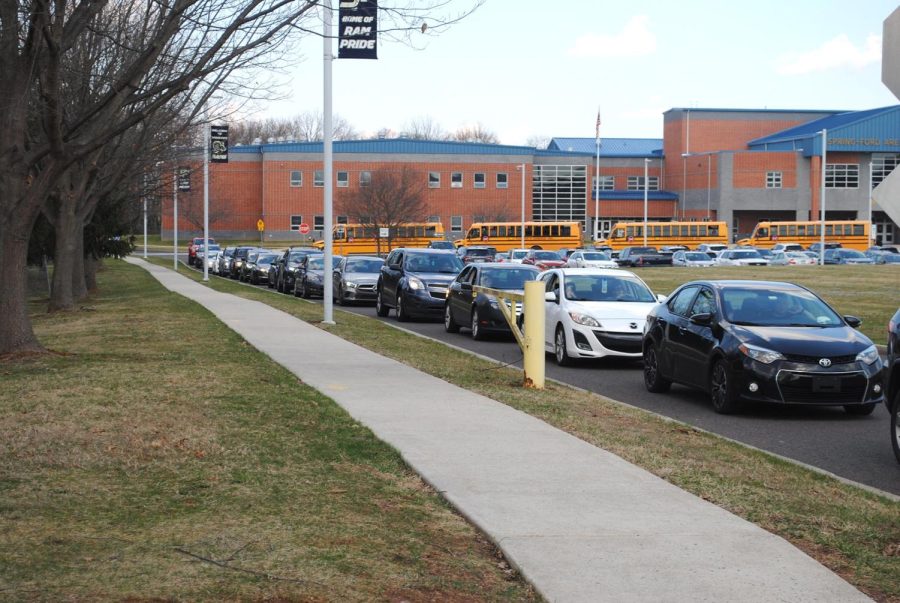Traffic Signals
Students adjust to congested roads as more students return and less students take buses.
Traffic drives out of the 10-12 Center parking lot towards Lewis Road in Royersford.
April 8, 2022
Midterm exams brought a resurgence of traffic issues to students’ morning commutes after a period of relative predictability during the second marking period.
Many students found themselves arriving late to their exams because of unforeseen traffic, losing critical time to complete assessments.
Spring-Ford’s traffic patterns vary throughout the school year, and can lead to unfortunate circumstances for students attempting to get to school on time during periods of increased congestion.
“The worst times of the year are the first few weeks, midterms, and the end of the year as well,” said Spring-Ford Police Chief David Boyer. “The roadway infrastructure was not designed to support the amount of traffic going to our schools and the amount of population growth and commuter traffic in our school district.”
Schools across the nation adjusted to increased traffic entering and leaving buildings this past fall. Spring-Ford was not immune to this dilemma, as Lewis Road congestion at times resembled a mall parking lot during the height of holiday season shopping.
School Principal Dr. Robert Colyer addressed the issue via morning announcement this past fall, urging students to leave their homes early enough to account for possible traffic jams. Students adjusted start times and traffic eased considerably by October.
A school as large as Spring-Ford is bound to have road congestion due the sheer volume of enrolled students – the traffic of the 2021 school year, however, has been particularly unpredictable.
The reasons for this change vary.
An increased number of parents opting to drive their children to school rather than send them by bus this past fall may have further populated the already crowded roads.
“Many parents have decided to drive their students to school instead of taking the bus for fears of possible exposure to the (COVID-19) virus,” Boyer explained.
According to the Pennsylvania Department of Motor Vehicles, the number of Pennsylvania students riding the bus to school has decreased by nearly 18,000 since 2019. This means that 18,000 more cars now populate the roads on school mornings, and would partially explain the increased traffic levels of the 2021 school year.
An additional issue is the bus driver shortage statewide.
“Throughout the Commonwealth, we currently have a little over 42,000 bus drivers, which is the lowest number of licensed CDL school bus drivers in the state that we have seen in the last five years,” explained Diego Sandigo, PennDOT press officer.
The deficit of drivers also affects students locally.
“The bus driver shortage has limited the amount of ‘runs’ or rotations the district is able to make with the amount of bus stops and arrivals we scheduled to deliver,” said Boyer of the impact of the bus driver shortage on district traffic patterns. “This means bus drivers are rotated for shortages and they may not be familiar with the bus route and the students they would normally pick up. This can delay the process and its efficiency.”
What intensifies the stress of the commute to school even further are the consequences of arriving at school late as Spring-Ford adheres to an unforgiving tardiness policy.
“Students will be required to report to a silent study hall after their third unexcused tardy in lieu of their assigned class,” reads the 2021-2022 Student Handbook. “They will receive a zero for that class and any class missed preceding their arrival on that date.”
Spring-Ford’s Student Handbook does not include traffic as a sufficient reason to deem a late arrival excused.
“I will say that compared to what was ‘normal’ of last year that I am experiencing a lot more latenesses this year,” said Spring-Ford High School Attendance Secretary Brittany Harrington earlier this fall. “Traffic was definitely a big source of late arrivals, especially in the beginning of the year.”
Students have largely settled into a routine that allows them to arrive at school in time for their first-period classes, despite the revival of intense traffic that occurred during midterms.
Because buses do not run on a schedule that aligns with the open-campus system adopted during midterms, many more students than usual opt to drive rather than take the bus. This led to more congested roads and lengthened commutes.
Spring-Ford’s traffic patterns make one clear suggestion: the district relies on bus drivers to limit traffic to manageable levels. Buses are crucial in limiting the number of vehicles on the road during any given morning, and traffic levels increase when students choose to forgo the bus.
Spring-Ford’s bus supplier, Custer’s Garage Inc., is now offering free training for new bus drivers without any experience required, and it is reasonable to assume that Spring-Ford parents, students, and staff are hoping their efforts prove successful.
There are actions that students can take to alleviate some of these traffic challenges.
“Just listen to our instructions,” Officer David Egleston said, referring to the traffic direction he and his colleagues provide to student and parent drivers each morning and afternoon during the school week.
Egleston controls the traffic light for drivers making a left turn into the 10-12 center. “If I make that arrow yellow, that’s me telling drivers to slow down,” he explained. According to Egleston, it is when drivers disregard these instructions and attempt to fly through that yellow light and become stuck in the intersection that problems arise.
Spring-Ford has multiple resources to alleviate traffic problems – school bus drivers and traffic officers both contribute to the morning commute running more smoothly. As long as Spring-Ford students and parents take advantage of these essential services, traffic will continue to be a manageable issue.

